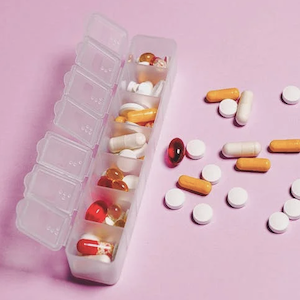Anti-tumor necrosis factor α: originators versus biosimilars, comparison in clinical response assessment in a multicenter cohort of patients with inflammatory arthropathies

Submitted: 16 June 2023
Accepted: 25 September 2023
Published: 19 December 2023
Accepted: 25 September 2023
Abstract Views: 1733
PDF: 414
Publisher's note
All claims expressed in this article are solely those of the authors and do not necessarily represent those of their affiliated organizations, or those of the publisher, the editors and the reviewers. Any product that may be evaluated in this article or claim that may be made by its manufacturer is not guaranteed or endorsed by the publisher.
All claims expressed in this article are solely those of the authors and do not necessarily represent those of their affiliated organizations, or those of the publisher, the editors and the reviewers. Any product that may be evaluated in this article or claim that may be made by its manufacturer is not guaranteed or endorsed by the publisher.
Similar Articles
- S. Alivernini, A.L. Fedele, I. Cuoghi, B. Tolusso, G. Ferraccioli, Citrullination: the loss of tolerance and development of autoimmunity in rheumatoid arthritis , Reumatismo: Vol. 60 No. 2 (2008)
- P. Frallonardo, R. Ramonda, F. Salaffi, M. Carotti, M. Andretta, P. Zucchetta, A. Dorigo, C. Campana, C. Contessa, A. Iagnocco, G. Valesini, R. Gerli, W. Grassi, L. Punzi, Sjögren’s syndrome: comparison among the main imaging techniques in the study of major salivary glands , Reumatismo: Vol. 60 No. 2 (2008)
- M. Favero, F. Schiavon, L. Riato, V. Carraro, L. Punzi, Septic arthritis: a 12 years retrospective study in a rheumatological university clinic , Reumatismo: Vol. 60 No. 4 (2008)
- R. Peluso, M. Atteno, S. Iervolino, V. Bruner, F. Caso, L. Costa, M. Raimodo, M. Lofrano, F. Manguso, R. Scarpa, Methotrexate in the treatment of peripheral arthritis in ulcerative colitis , Reumatismo: Vol. 61 No. 1 (2009)
- R. Scrivo, F. Conti, F.R. Spinelli, S. Truglia, L. Magrini, M. Di Franco, F. Ceccarelli, G. Valesini, Switching between TNFα antagonists in rheumatoid arthritis: personal experience and review of the literature , Reumatismo: Vol. 61 No. 2 (2009)
- L. Quartuccio, S. Salvin, M. Saracco, S. Lombardi, M. Fabris, E. Mansutti, M. Maset, S. Pellerito, S. De Vita, Rheumatoid factor positivity rather than anti-CCP positivity, a lower disability and a lower number of anti-TNFα agents failed are associated with response to rituximab in rheumatoid arthritis , Reumatismo: Vol. 61 No. 3 (2009)
- G. Tansir, P. Kumar, A. Pius, S.K. Sunny, M. Soneja, Pseudo-pseudo Meigs’ syndrome: a rare presentation of systemic lupus erythematosus , Reumatismo: Vol. 71 No. 2 (2019)
You may also start an advanced similarity search for this article.

 https://doi.org/10.4081/reumatismo.2023.1602
https://doi.org/10.4081/reumatismo.2023.1602





